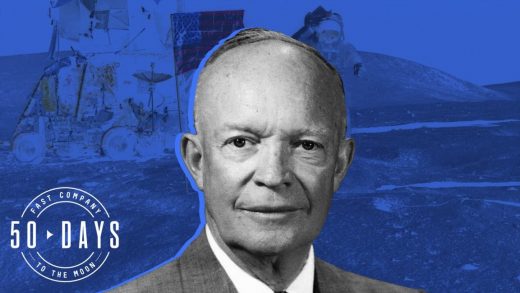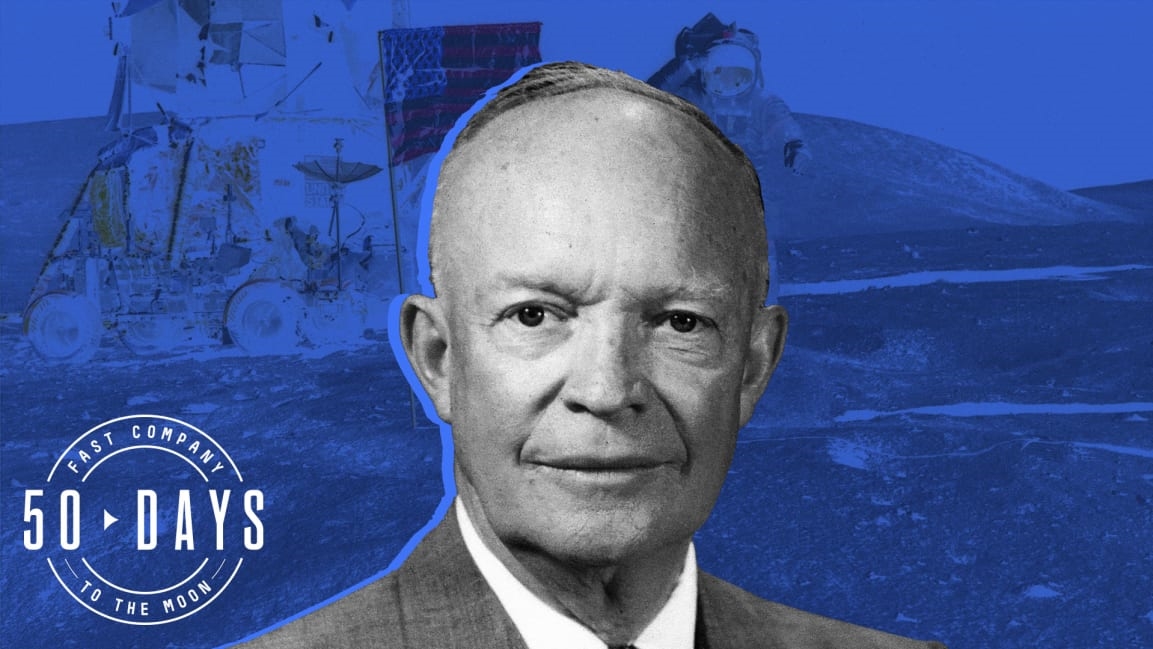The race to the Moon was so unpopular at one point, President Eisenhower called JFK ‘nuts’
This is the 44th in an exclusive series of 50 articles, one published each day until July 20, exploring the 50th anniversary of the first-ever Moon landing. You can check out 50 Days to the Moon here every day.
For decades, it has been an unwritten rule that a former U.S. President doesn’t criticize his successor. But sometimes they can’t resist, especially when they are speaking in private.
That’s how former President Dwight Eisenhower came to call President John Kennedy “nuts.” Or at least call his race to the Moon “nuts.”
Eisenhower wasn’t just speaking his own mind when he said that in 1963. He was channeling a growing chorus of skepticism, just a couple years into the Apollo program, about what it cost and what it would get us.
But that wasn’t how things had started, of course.
On the day after President John F. Kennedy challenged Americans to go to the Moon, there was a wave of enthusiasm and support for the mission.
The Washington Post story after the speech said of Congressional reaction to JFK’s Moon race, “The President will get everything he asked for.”
No one could resist a good, or even meager, space metaphor.
“The President may be asking for the Moon,” said Senate Majority Leader Mike Mansfield (D, Montana), “but he’s shooting for the stars.” One grumpy Republican—who only spoke anonymously—told the Post, “President Kennedy’s deficit is going to reach the Moon before we do.”
In fact, Congress had been agitating for a more vigorous space program—and even for more spending on space—for years. At a hearing just a month earlier, the day after Russia launched the first human being into space, frustrated Republican Congressman James Fulton (Pa.), said to the head of NASA: “Tell me how much money you need (to catch the Russians) and this committee will authorize all you need.”
There’s a phrase not commonly heard in Congress: Just tell us how much money you need!
Kennedy had warned everyone—Congress, the public—that going to the Moon would take years and require patience, as well as billions of dollars.
In fact, in that very first speech, Kennedy put it very well: “If we are to go only half way, or reduce our sights in the face of difficulty, in my judgment, it would be better not to go at all.”
There is no “half way to the Moon,” as there might be, for instance, 500 miles of interstate instead of 1,000. If you start spending money furiously to develop Moon rockets and lunar modules and spacesuits, and then quit a few years in, you not only don’t go to the Moon, you have, in fact, wasted all the billions you spent getting started.
But Americans in 1961 didn’t have attention spans any longer than we have today.
Just months after the Moon race was launched, by that fall, there were prominent, and increasingly clever, voices of dissent.
Norbert Wiener, a professor and highly regarded mathematician at MIT (where the work designing Apollo’s navigation system and onboard computer would be done), dismissed the race to the Moon in a late 1961 interview as a “moondoggle,” a word the press and NASA critics loved. Through the end of 1961 and into 1962, “moondoggle” started to pop up regularly in coverage of the space program, particularly in stories and editorials about spending.
In January 1962, the New York Times published an editorial pointing out that “the grand total for the Moon excursion would reproduce from 75 to 120 universities about the size of Harvard, with some [money] left over.” A Moon landing or a Harvard University for every state?
Nine months later, the Times asked somewhat churlishly, “In view of the country’s late start [in space], is it wise to stake so much of the nation’s prestige on the proposition that an American will reach the Moon first? . . . There are manned landings on Mars and Venus, for example, to shoot at too.” Returning to the idea of building a Harvard in every state, the Times noted, “This country still has tremendous need for more schools, more hospitals, more housing . . . . The American people must never lose sight of the fact that, while ardently competing with the Soviet Union in space, a concurrent goal is to create a better world here on Earth.”
That was the New York Times, which seven years later would devote 18 pages in a single day to covering the first Moon walk, including a page of poems.
In 1963 the politics of going to the Moon got even more challenging. In April, in an editorial in the prestigious journal Science, the magazine’s editor Philip Abelson provided a cerebral, almost disdainful, critique of Kennedy’s mission to the Moon.
Abelson walked through each justification—military value, technological innovation, scientific discovery, and the propaganda value of beating the Russians—and dismissed each in turn. As for the worldwide prestige of being first to the Moon, Abelson made a withering prediction.
“The lasting propaganda value of placing a man on the Moon has been vastly overestimated,” he wrote. “The first lunar landing will be a great occasion; subsequent boredom is inevitable.”
Abelson managed to be savagely correct and brilliantly wrong in the same sentence, of course. The public did lose interest in the Moon missions, all too quickly. But the worldwide prestige of going to the Moon was bigger, more powerful, and longer lasting than anyone could have imagined.
An editorial in Science was hardly a popular uprising against going to the Moon. But the next morning Abelson was on NBC’s Today show to make the same case. The New York Times covered the editorial. The Washington Post also wrote a story about it, and then did a three-part series on the question of whether the Moon race was scientifically justified, or merely “a stunt.” The Post series was titled “Moon Madness?”
On June 10, Abelson was one of a group of scientists called to testify before the Senate Committee on Aeronautical and Space Sciences about the future of Apollo. Abelson, a physicist and a key contributor to the creation of the atomic bomb, told the senators, “[The] diversion of talent to the space program is having and will have direct and indirect damaging effects on almost every area of science, technology, and medicine. I believe that [Apollo] may delay the conquest of cancer and mental illness. I don’t see anything magical about this decade.
“The Moon has been there a long time, and will continue to be there a long time.”
Abelson was a physicist, and also a brilliant politician. The Moon has been there a long time—what’s the hurry?—and it would border on the criminal if going to the Moon delayed curing cancer.
But hard as it is to disentangle societal changes and their causes, most analysis seems to show that, rather than undermining science, Apollo accelerated the development of a huge range of technology and scientific development, and inspired a whole generation of new scientists and engineers.
Abelson’s Senate testimony came on a Monday. Two days later, on June 12, former President Eisenhower spoke to a breakfast gathering of Republican members of Congress in Washington, where he was sharply critical of Kennedy’s spending plans overall. It was a private event, and reporters weren’t admitted. But there were more than 160 Republican Congressmen at the breakfast, and reporters quickly tracked down the juiciest parts of Eisenhower’s critique.
Asked specifically about the space budget, Eisenhower replied, “Anybody who would spend $40 billion in a race to the Moon for national prestige is nuts.” The line reportedly drew sustained applause from the Republicans at the event. (Apollo, ultimately, would cost less than $20 billion.)
Headline writers from one side of America to the other loved the story, which made the front pages of dozens of newspapers with some variation of the headline “Ike Says ‘Nuts’ to Moon Race.”
Kennedy, for his part, ignored Eisenhower’s assessment.
President Eisenhower was well-known for being dubious of space excitement. He had been born in 1890—firmly in the horse-and-buggy-era—and had lived through the successive revolutions of electricity, the automobile, the telephone, radio, television, the airplane, and the intercontinental ballistic missile.
Sputnik was launched during the first year of Eisenhower’s second term, and he wasn’t just unruffled by it, he couldn’t fathom why a public that had survived Pearl Harbor and Normandy was so unhinged by a beach-ball sized satellite whirling overhead.
“I can’t understand why the American people have got so worked up over this thing,” Eisenhower told his advisors at a private White House meeting. “It’s certainly not going to drop on their heads.”
Charles Fishman, who has written for Fast Company since its inception, has spent the past four years researching and writing One Giant Leap, his New York Times best-selling book about how it took 400,000 people, 20,000 companies, and one federal government to get 27 people to the Moon. (You can order it here.)
For each of the next 50 days, we’ll be posting a new story from Fishman—one you’ve likely never heard before—about the first effort to get to the Moon that illuminates both the historical effort and the current ones. New posts will appear here daily as well as be distributed via Fast Company’s social media. (Follow along at #50DaysToTheMoon).
(37)



